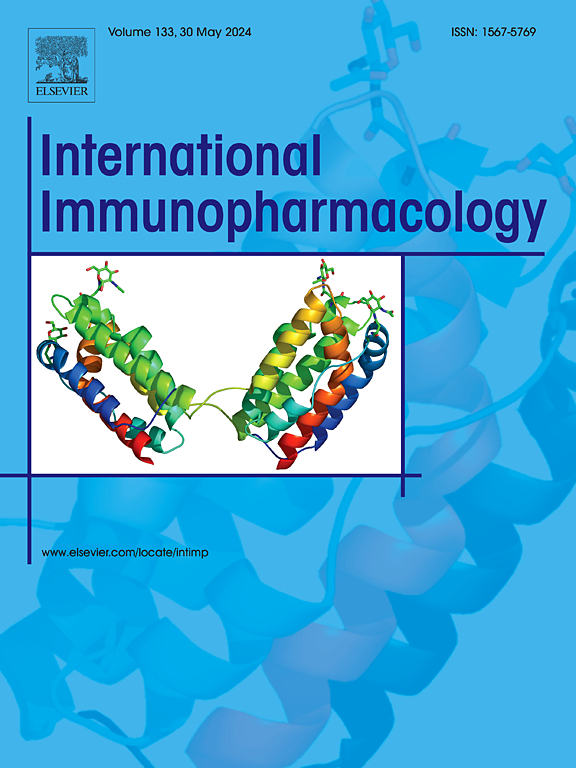miR-29a nanoparticles improve chronic insomnia by regulating microglia activation and hippocampal neuronal cell pyroptosis through PER2/NF-κB axis
IF 4.8
2区 医学
Q2 IMMUNOLOGY
引用次数: 0
Abstract
Objective
Chronic insomnia can easily lead to clinical distress or cause mental, social, physical, educational, occupational, or other functional impairments. Considering the role of circadian rhythm in insomnia, we focused on exploring the action of miR-29a in regulating the PER2 gene in improving chronic insomnia.
Methods
LPS induces the expression of miRNAs targeting PER2 in HMC3 and PRM cells, which was verified by RT-qPCR. Poly-lactic-co-glycolic acid (PLGA) nanoparticles (NP) were used to encapsulate short hairpin (sh)-miR-29a to construct sh-miR-29a-NP. Morris water environment method was employed to establish a sleep deprivation rat model to investigate the therapeutic effects of sh-miR-29a-NP. Cell viability and levels of cell polarization factors were evaluated using CCK8 and ELISA, respectively. The Morris water maze test was applied to assess the learning and memory capabilities of the rats. Immunohistochemistry, immunofluorescence, and western blot were applied to test the expression of glial cell polarization, neuronal cell activation, apoptosis, and Period2 (PER2) /nuclear factor kappa B (NF-κB) axis proteins.
Results
miR-29a was significantly upregulated in LPS-induced HMC3 and PRM cells, with the most significantly altered miRNAs/PER2 interaction. In LPS-induced HMC3 and PRM cells, sh-miR-29a promoted the PER2 and CD206 expressions, and inhibited the expression of ionized calcium-binding adaptor molecule 1 (IBA-1), NF-κB, and CD86, while this effect was blocked by small interfering-PER2. Further in vivo experiments confirmed that PER2 and CD206 expression was reduced, while NF-κB, CD86, and IBA-1 expression were up-regulated in the hippocampal tissue of CSD rats. However, this effect was reversed by treatment with sh-miR-29a-NP. Treatment with sh-miR-29a-NP in CSD rats shortened the escape latency and increased the number of crossings over the original platform, while inhibited the expression of NLR Family Pyrin Domain Containing 3, caspase-1, Gasdermin D (GSDMD), and TUNEL signal in the hippocampal tissue.
Conclusion
The regulation of PER2/NF-κB pathway by sh-miR-29a-NP promoted M2 polarization of microglial cells and inhibited neuronal cell pyroptosis, thereby improving cognitive dysfunction in chronic insomnia.
miR-29a纳米颗粒通过PER2/NF-κB轴调控小胶质细胞活化和海马神经元细胞焦亡,改善慢性失眠
目的慢性失眠很容易导致临床痛苦或导致精神、社会、身体、教育、职业或其他功能障碍。考虑到昼夜节律在失眠中的作用,我们重点探讨了miR-29a在调节PER2基因改善慢性失眠中的作用。方法slps诱导HMC3和PRM细胞中靶向PER2的mirna表达,并通过RT-qPCR进行验证。采用聚乳酸-羟基乙酸(PLGA)纳米颗粒(NP)包封短发夹(sh)-miR-29a构建sh-miR-29a-NP。采用Morris水环境法建立睡眠剥夺大鼠模型,探讨sh-miR-29a-NP的治疗作用。分别用CCK8和ELISA检测细胞活力和细胞极化因子水平。采用Morris水迷宫实验评估大鼠的学习记忆能力。采用免疫组织化学、免疫荧光和western blot检测神经胶质细胞极化、神经元细胞活化、凋亡和周期2 (PER2) /核因子κB (NF-κB)轴蛋白的表达。结果在lps诱导的HMC3和PRM细胞中,smir -29a显著上调,其中miRNAs/PER2相互作用的改变最为显著。在lps诱导的HMC3和PRM细胞中,sh-miR-29a促进了PER2和CD206的表达,抑制了离子钙结合适配器分子1 (IBA-1)、NF-κB和CD86的表达,但这种作用被小干扰-PER2阻断。进一步的体内实验证实,CSD大鼠海马组织中PER2、CD206表达降低,NF-κB、CD86、IBA-1表达上调。然而,用sh-miR-29a-NP治疗后,这种效果被逆转。sh-miR-29a-NP在CSD大鼠中缩短了逃避潜伏期,增加了原始平台上的交叉次数,同时抑制了海马组织中NLR家族Pyrin Domain Containing 3、caspase-1、Gasdermin D (GSDMD)和TUNEL信号的表达。结论sh-miR-29a-NP调节PER2/NF-κB通路,促进小胶质细胞M2极化,抑制神经元细胞焦亡,从而改善慢性失眠症患者的认知功能障碍。
本文章由计算机程序翻译,如有差异,请以英文原文为准。
求助全文
约1分钟内获得全文
求助全文
来源期刊
CiteScore
8.40
自引率
3.60%
发文量
935
审稿时长
53 days
期刊介绍:
International Immunopharmacology is the primary vehicle for the publication of original research papers pertinent to the overlapping areas of immunology, pharmacology, cytokine biology, immunotherapy, immunopathology and immunotoxicology. Review articles that encompass these subjects are also welcome.
The subject material appropriate for submission includes:
• Clinical studies employing immunotherapy of any type including the use of: bacterial and chemical agents; thymic hormones, interferon, lymphokines, etc., in transplantation and diseases such as cancer, immunodeficiency, chronic infection and allergic, inflammatory or autoimmune disorders.
• Studies on the mechanisms of action of these agents for specific parameters of immune competence as well as the overall clinical state.
• Pre-clinical animal studies and in vitro studies on mechanisms of action with immunopotentiators, immunomodulators, immunoadjuvants and other pharmacological agents active on cells participating in immune or allergic responses.
• Pharmacological compounds, microbial products and toxicological agents that affect the lymphoid system, and their mechanisms of action.
• Agents that activate genes or modify transcription and translation within the immune response.
• Substances activated, generated, or released through immunologic or related pathways that are pharmacologically active.
• Production, function and regulation of cytokines and their receptors.
• Classical pharmacological studies on the effects of chemokines and bioactive factors released during immunological reactions.

 求助内容:
求助内容: 应助结果提醒方式:
应助结果提醒方式:


